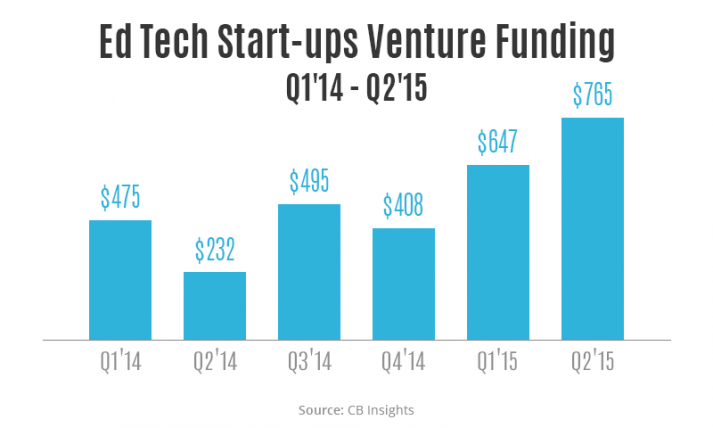In recent years a host of digital start-ups have sprung up across every area of life, and education is no exception. In 2014, around $1.6bn was reportedly poured into ed tech start-ups. But can the solutions offered actually make a difference to students and teachers? As Mukul Krishna, Global Director of Digital Media Practice for Frost & Sullivan, says: “Technology is not going to change anything — it’s how technology is used that makes all of the difference.”
Ed Tech’s Shining Solutions
1. Peer Learning & Collaboration
Technology dilutes hierarchical boundaries of traditional learning in a classroom, and turns a teacher from a sole possessor of unique knowledge into a mentor vectoring the learning process. Education on the web is gradually evolving from forum threads and discussion communities into fully-fledged online academies and self-organised peer communities, where any holder of knowledge becomes a teacher. Examples of such peer education hubs are P2PU, which offers a DIY collaborative approach to teaching and learning, and “headless” open online courses like DS106, an exchange of peer knowledge and an emerging edupunk philosophy.
2. Free Access
Another truly open form of online education is Massive Open Online Courses (MOOCs). Originally, this alternative to professional training came out of affiliation with classic brick-and-mortar universities such as MIT and Harvard. MOOCs give access to college- or university-based syllabi so that students from all over the world have the chance to join the hotbeds of knowledge. They can and take up a course, for example, in Digital Storytelling by Iversity or Human Computer Interaction by Coursera. Today this open approach is also being integrated into peer universities embracing the ethos of “education for everyone”.
 3. Affordability
3. Affordability
The rise of digital media has lowered the financial bar for the entrance into the world of higher education. With student loans becoming increasingly difficult to obtain and pay off, avid learners can explore free options to compensate for often prohibitive costs of education. Today you can find anything from online tutorials by W3Schools and YouTube lessons to lectures on TED. Book of Cool provides showroom videos, educating viewers in dexterity and other practices. There are full-scale online academies such as Codeacademy or primarily STEM-facing Khan Academy. In a well-developed culture of self-learning, those with professional ambitions now have the affordable resources they need to propel their career.
4. Automation & Data Management
An instrumental role of education technology, though often overlooked, is to automate routine admin activities in order to free up teaching staff. Stand-out solutions include Remind101, a parent and pupil SMS notification service, Clever, a startup that has recently raised more than $10.3 m to facilitate student user account management and Panorama Education, providing data analytics and surveys of teachers, parents and students. These technologies all create an opportunity to better focus on pedagogical issues.
5. Multicultural & Dynamic Learning
Technology is creating an environment for exploring better the world around us, uniting students in collaborative problem-solving and fostering the mindset of social responsibility. Mobile devices give students the opportunity to use a geography-agnostic approach. On top of that, they are great tools that aid in field activities and environment-centric research. While solutions such as Think Spot, a social learning platform for the unique education project Think Global School, and TIGed, one of TakingITGlobal programs, foster global citizenship and help educators raise a generation of change makers.
6. Didactical Aid
Digital advancements have brought our most fantastical childhood dreams to life. More importantly, these virtual reality devices, 3D printers and other gizmos are becoming relatively affordable. This means that these innovations can serve not only as ATV devices for people with special abilities, but can also be used as didactical aids in a classroom, for instance, emulating environments for an astrology class.
7. Adaptive Learning
The concept of adaptability in the digital world goes beyond a multi-screen and multi-device design approach. Ed tech solutions are progressing to incorporate adaptability into the learning process in order to fit the individual pace of knowledge acquisition for every single learner. Algorithms that scan and predictively analyse content consumed by each student can provide a personalized recommendation-based experience. Knewton, Smart Sparrow and NoRedink are pioneers in this sphere.
Adoption is Key
To find the best “next-generation” education solutions, don’t rely on a media-generated buzz. As Beck Splitt, CEO at StudyBlue, says: “the most successful ed tech companies among students, teachers and institutions often get ignored by the mainstream media due to a misplaced focus on ‘world-changing innovation’ instead of effectiveness.” Ed tech’s success can be measured in its practical application and genuine appeal among those who use them – educators and students.
Softeq is a company offering custom software development services: www.softeq.com. Softeq provides full-cycle development support at all levels – embedded, web and mobile – and helps its clients with tech-intensive and research-driven initiatives in eLearning, IoT, enterprise and industrial automation areas.
